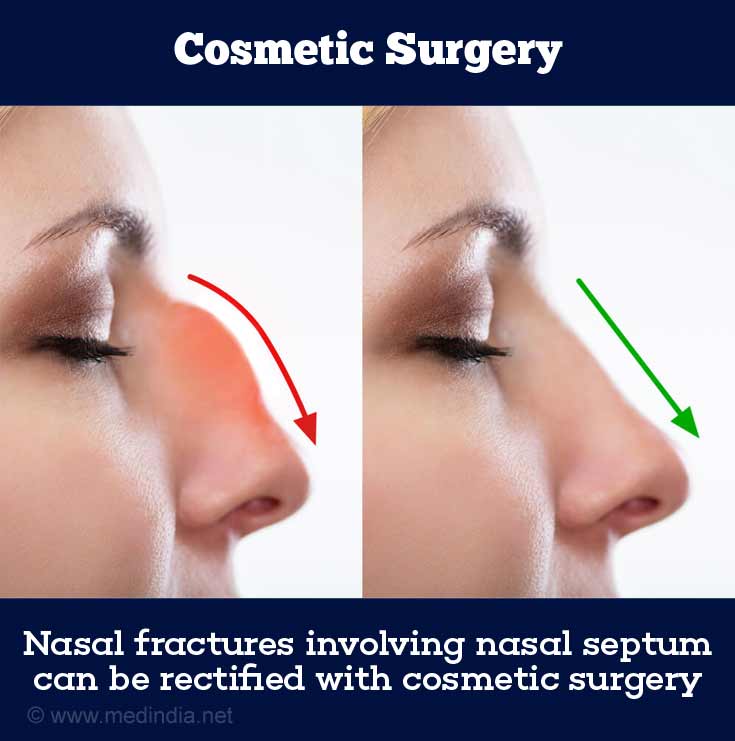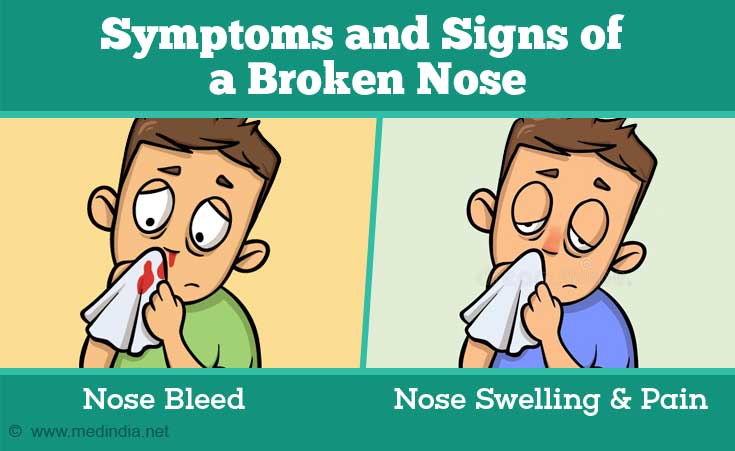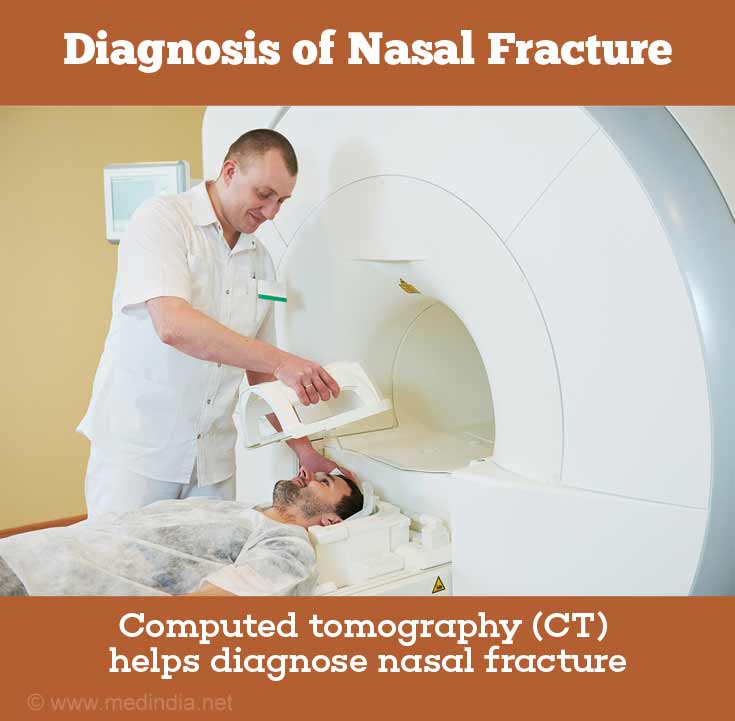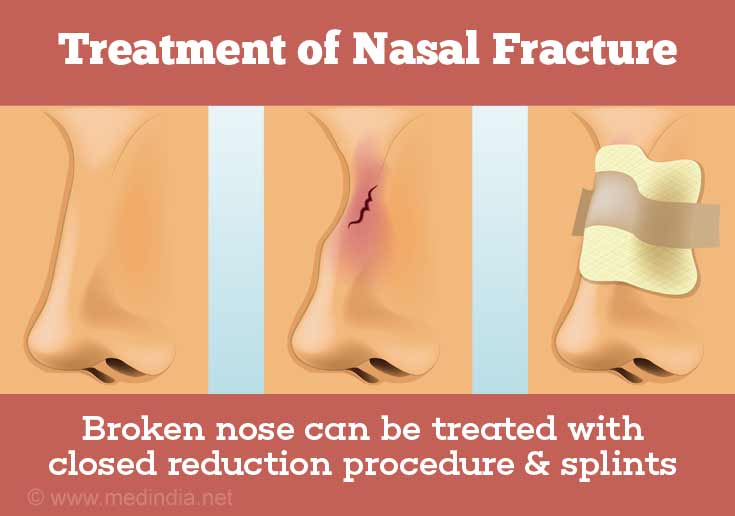- Nasal Fracture - (https://en.wikipedia.org/wiki/nasal_fracture)
- Nasal Fracture Reduction - (https://www.ncbi.nlm.nih.gov/books/NBK538299/)
- Nasal Fractures - Symptoms - (https://www.enthealth.org/conditions/nasal-fractures/)
- Nasal Bone Fracture - (https://radiopaedia.org/articles/nasal-bone-fracture)
- Broken Nose (Nasal Fracture) - (https://www.health.harvard.edu/a_to_z/broken-nose-nasal-fracture-a-to-z)
About
We are all familiar with the stereotype of a broken nose in the movies. The man gets into a fight, suffers a blow to the nose, and is seen walking around with a tape around his nose. However, there is more to the broken nose than meets the eye. Nose fracture or nasal fracture or broken nose indicates a break in the cartilage or bone or the septum of the nose.
The first record of a nasal injury or fracture was around 1600 BC in the Edwin Smith papyrus. Nasal fractures account for 40% of injuries of the bone. Nasal fractures tend to occur due to vehicle accidents, fights, or falls during play.
Nasal fractures typically occur in individuals (males) in the age group of 15 to 30 years old. Infants suffer from nasal fractures during the time of delivery. Young children suffer from nasal fractures during play, though they are not that common since the nasal bones are not fragile. However, if a child suffers a nasal fracture, it does not heal well since the bones and the cartilage are not well developed in a child. Nasal fractures can also be observed in women and children due to physical abuse.
To understand the nature of nasal fractures, one must understand the nasal anatomy. The upper part of the base of the nose is formed by bony processes from the frontal and maxillary bones which join in the midline. The lateral walls also contain small nasal bones called conchae, which form the turbinates. The septum, which separate the two nostrils is formed by a cartilage. The lateral parts of the nose contain the upper lateral and lower lateral cartilages.(1✔ ✔Trusted Source
Nasal Fracture
Go to source)
Nasal Fractures - Types
Nasal fractures were first classified in the twentieth century by Le Fort. Other classifications followed, however, a universally accepted form of classification of nasal fractures is not available. In a recent study in 2006, nasal fractures were classified into 6 types based on the fracture of the nasal bones alone or in combination with the fracture of the nasal septum.
In general, some of the main types of nasal fractures are as follows:
1. Nasal fractures involving the nasal septum: Most nasal fractures involve the nasal septum. Based on the type of damage to the nasal septum, one can determine the treatment to be provided. If the nose is subjected to a force of weak impact, the nasal septum does not get damaged. However, when the impact is high, the nasal septum is damaged. The nasal passage is affected due to the fractures in the nasal septum. Treatment is based on the extent of damage to the nasal septum. When the nasal septum is damaged, the cartilagenous support of the nose is affected. The damage can be rectified with cosmetic surgery.

2. Separation of the upper lateral cartilage: In this case, the upper lateral cartilage is torn away. This type of injury may be noted in a car accident when the steering wheel hits the nose on impact. Computed tomography (CT) scan is better than plain x-ray in diagnosing this condition.
3. Lateral displacement of nasal fractures: This is the most common form of nasal fractures. The nasal bones get pushed and displaced when the nose suffers a blow from the side. There is also a displacement of the nasal septum.
4. Fractures of the anterior nasal spine: The anterior nasal spine is a small bony projection in the anterior midpoint of the nose. These fractures occur individually or in conjunction with other nasal fractures. They do not require any treatment if they occur without any other nasal fractures.
5. Fractures with a posterior depression: Following a nasal blow from the front, the nasal bones are pushed to the posterior. The nasal septum is also involved in this process.
In addition, nasal fractures are commonly observed in patients who have undergone plastic surgery. The nasal fractures in such patients have been classified based on the site of the fracture such as -
- Type I (at the higher level of the nasal bones),
- Type II (at the lower level of the nasal bones),
- and type III (fractures in the total nasal bone).(2✔ ✔Trusted Source
Nasal Fracture Reduction
Go to source)
Symptoms and Signs of a Broken Nose or Nasal Fracture
Symptoms and signs of a nasal fracture include the following:
- Swelling of the nose
- Runny nose: At times, following a head injury or surgery, there is a continuous discharge from the cerebrospinal fluid into the nose (CSF rhinorrhea).
- Pain in the nose.
- Crooked or bent nose: The nose or the tip of the nose undergoes a change in the appearance. At certain times, there may be a loss or change in the perception of smell.
- Persistent bleeding through the nose (epistaxis)
- Presence of a hole in the nasal septum that divides the nose. At other times, there is a breakdown in the nasal septum.
- Bruising around the nose and under the eyes
- Blocked nasal passages, resulting in difficulty in breathing
- When the nose is touched, one experiences an irritating grating sound.
- The presence of a large quantity of blood or hematoma in the nose (nasal septal hematoma). At times, there is a discharge of blood from the nose. If the blood is not removed, a deformity is formed in the nose or an abscess can occur that blocks the nose.(3✔ ✔Trusted Source
Nasal Fractures - Symptoms
Go to source)

Diagnosis of Nasal Fractures
Nasal fractures can be diagnosed with a physical examination and a relevant medical history. Doctors enquire from the patients on any previous nasal fractures, the nature of the nasal fracture, and the kind of treatment accessed for the nasal fracture. The physician will also enquire if the patient experienced a prior traumatic fracture of the nose with concurrent hemorrhage.
A physical examination of the patients will detect a swelling at the bridge of the nose. An external examination of the patient includes palpation of the nose with the fingers. The shape of the nose is affected following the fracture.
The physician examines the bones, nasal septum, and analyzes the deformity in the nose through the change in the shape or any associated swelling in the nose.
In an internal examination, the presence of a hematoma or blood clot in the nose is assessed with a cotton-tip applicator or a nasal speculum. The nasal speculum is an instrument with a broad tip that aids in gently separating the nose to check for any injury within the nose and potential blood clots.
A computed tomography (CT) scan is valuable in identifying the type of nasal fracture and to understand the extent of damage to the nose and other facial bones.

Radiographs or X-rays are not useful in ascertaining the type of fracture or to determine the treatment regimen.(4✔ ✔Trusted Source
Nasal Bone Fracture
Go to source)
Treatment of Nasal Fractures
The treatment of a nasal fracture depends on the extent of damage to the nose. The first measure is to put an ice pack on the swollen nose and to keep the head in a raised position.
Acetaminophen can be consumed within 48 hours of the injury to take care of pain but it is best to avoid nonsteroidal anti-inflammatory drugs during the first 48 hours.
If there is persistent bleeding in the nose (called
In the first few days of the fracture to the nose, the physician may attempt to restore the shape of the nose through nonsurgical means. If the fracture is minor, the physician will wait a few days for the swelling to reduce before attempting to reshape the nose and bring the bend to normal. Bone fractures need to be examined once the swelling subsides.
In the first 10 days, a closed reduction procedure that does not involve surgery is used to reshape the nose.

After 10 days of the injury, a surgical procedure, rhinoplasty or plastic surgery of the nose helps in reshaping the nose.
Septorhinoplasty is plastic surgery of the nasal septum.
Antibiotics are administered during treatment to avoid infection. The patient should be questioned wth regards to understanding the original shape of the nose and the extent of the change. This aids in restoration of the shape of the nose.(5✔ ✔Trusted Source
Broken Nose (Nasal Fracture)
Go to source)









